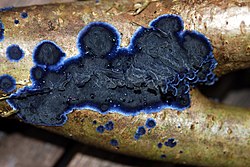
Back Corticioide Catalan قارچهای پینهای Persian Orvakat Finnish Champignon corticioïde French Grzyby kortycjoidalne Polish Fungos corticioides Portuguese Кортиціоїдні гриби Ukrainian

The corticioid fungi are a group of fungi in the Basidiomycota typically having effused, smooth basidiocarps (fruit bodies) that are formed on the undersides of dead tree trunks or branches. They are sometimes colloquially called crust fungi or patch fungi. Originally such fungi were referred to the genus Corticium ("corticioid" means Corticium-like) and subsequently to the family Corticiaceae, but it is now known that all corticioid species are not necessarily closely related. The fact that they look similar is an example of convergent evolution. Since they are often studied as a group, it is convenient to retain the informal (non-taxonomic) name of "corticioid fungi" and this term is frequently used in research papers[1] and other texts.
- ^ Larsson K-H, Larsson E, Koljalg U. (2004). High phylogenetic diversity among corticioid homobasidiomycetes. Mycological Research 108: 983–1002.
© MMXXIII Rich X Search. We shall prevail. All rights reserved. Rich X Search